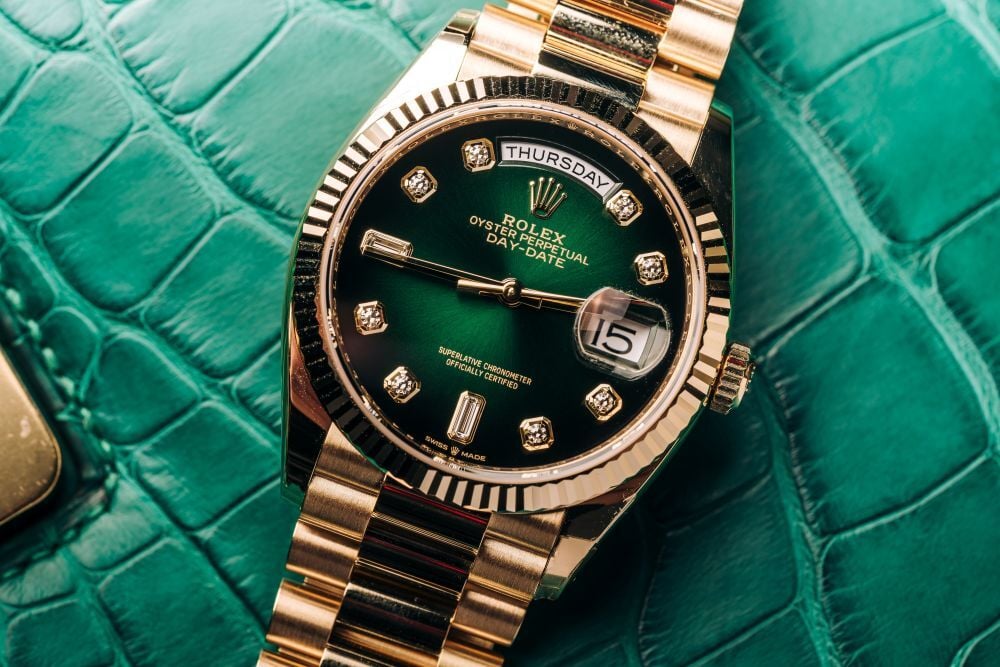Rolex Explorer: The Watch Made for Everest and Beyond
Of all Rolex’s tool watches, none embodies the brand’s original spirit of adventure more directly than the Explorer. Released in 1953 – the same year as the Submariner and Turn-O-Graph – the Explorer was purpose-built for the high-altitude, icy climes of Everest, crafted quite literally for environments where accurate timekeeping is key to survival. Over the decades, it has remained one of Rolex’s most unchanged references: deliberately austere, time-only, and symbolic of human achievement. As one of the most specialised and visually plain tool watches in the Rolex catalogue, the Explorer has maintained a small but loyal collector base – its legacy anchored firmly in historic expeditions.

The Origins of The Explorer – The Top of the World
The Explorer is tied inextricably to one of the 20th century’s greatest outdoor achievements: the successful summit of Mount Everest. In May 1953, Sir Edmund Hillary and Tenzing Norgay became the first climbers confirmed to reach the top of the world’s highest peak, following years of previous attempts. As a sponsor, Rolex provided them with a number of prototype Oyster Perpetuals to test at frigid altitudes, and they performed flawlessly. Although it was a Smiths timepiece that ultimately made it to the very summit on Hillary’s wrist, Rolex – never one to miss a marketing opportunity – seized the moment. Later that year, the brand launched the Explorer as a tribute to the historic ascent, forever entwining the model with human endurance and high-altitude exploration.
Throughout the ‘50s and ‘60s, the Explorer was put to the test further in oxygen-thin, sub-zero conditions, including the 1955–56 Trans-Antarctic Expedition to the South African National Antarctic Programme, whereby the piece held up in sub–50°C temperatures and strong magnetic fields.
Read More: Rolex Datejust
The Rolex Explorer Today – Specifications and Market Value
For all its history, the Explorer today is refreshingly restrained and remarkably faithful to its original minimalist design. Still forged in Oystersteel, the current references – 124270 (36mm) and 224270 (40mm) – carry the same DNA as their predecessors: a clean black or white dial, the signature 3-6-9 layout, and a no-date, time-only display. Both are powered by the in-house calibre 3230, which delivers a 70-hour power reserve, enhanced shock resistance, and Rolex’s proprietary Chronergy escapement. One of the more significant modern updates to the Explorer has been in dial luminosity. Patented Chromalight lume has replaced older tritium and radium formulas, offering a cooler tone and longer-lasting glow in low light.
At retail, the Explorer remains one of the more attainable professional Rolex models. In the UAE, the 36mm version is currently priced at AED 29,800, with secondary market listings sitting just below retail – a sign of healthy supply and measured demand. The two-tone Rolesor 36mm is the most expensive Explorer in the lineup, priced at AED 52,500. Older references like the 1016 and 114270 have developed strong collector followings, but even so, the Explorer remains one of Rolex’s most stable models – a dependable piece for those who favour substance over spectacle.
Read More: Rolex Daytona
Notable Examples of the Rolex Explorer
Rolex Explorer Reference 6350 (1953) – The First “Explorer” Model
Released in the months following the Everest summit, the 6350 is widely considered the first true Rolex Explorer – the reference that formally united name and purpose. At a glance, it resembles the early Oyster Perpetuals of the 1950s, with a slim 36mm steel case and self-winding movement. A vintage grail, certain 6350 examples were produced with a rare gilt honeycomb dial and large radium-painted numerals, some of which have aged over time to a warm orange patina. Known among collectors as the “pumpkin” effect, this trait is now one of the most coveted in vintage Rolex collecting. In December 2023, a rare honeycomb Explorer ref. 6350 sold for $48,260 at a Sotheby’s auction.
Read More: Rolex Submariner
Rolex Explorer Reference 1016 (1963–1989) – The Adventurer’s Watch
For many, the 1016 is the definitive Rolex Explorer. Produced for over 25 years with minimal changes, it remains one of the longest-running references in Rolex history – a simple, confident design that never needed reinvention. With an upgraded internal calibre and improved dial, this is the reference that cemented the Explorer’s reputation as a tool for real-world expeditions. One notable example was loaned to South African explorer Graham Blyth during the 1980s SANAE Antarctic mission, where it endured temperatures below –50°C and maintained precise timekeeping throughout. This reference even has some literary history: author Ian Fleming, who wore a 1016 himself, described Bond’s timepiece as a “heavy Rolex Oyster Perpetual” with luminous numerals – widely interpreted as a nod to the Explorer.
Read More: Most Expensive Rolexes Ever Sold
Rolex Explorer II Reference 1655 (1971) – The “Steve McQueen” Explorer
Launched in 1971, the Explorer II marked Rolex’s first major departure from the original Explorer line – a specialist’s watch built for darkness rather than altitude. The reference 1655 featured a fixed 24-hour bezel and a vivid orange hand designed to help cave and polar explorers distinguish night from day. With its cluttered matte dial, dense minute track, and arrow-shaped “Freccione” hand, the watch stood apart from every other Rolex of the era and was initially a slow seller. Over the years though, it has earned cult status among vintage collectors.
Part of its mythology stems from a long-standing marketing error: a 1970s Italian magazine claimed actor Steve McQueen wore the watch, despite no evidence to support this (McQueen famously wore a Submariner). Still, the nickname stuck – and the legend grew. Today, the 1655 is the most desirable vintage Explorer, with well-preserved examples valued above AED 200,000 on the secondary market.
Read More: Iconic Rolex Models
Final Thoughts
Forged in celebration of mankind’s triumph over nature’s extremes, the Explorer remains one of Rolex’s most pure and purpose-driven creations. It doesn’t chase trends or dazzle with complications – and that’s precisely why it endures. While certain vintage references, particularly those linked to early expeditions or rare dial variants, have become coveted collector’s pieces, the Explorer remains one of the most accessible models in the Rolex catalogue, priced roughly on par with the Oystersteel Datejust. More than seventy years on, it’s a reminder that in both watchmaking and mountaineering, function prevails over flash.

-jpg.jpeg)

